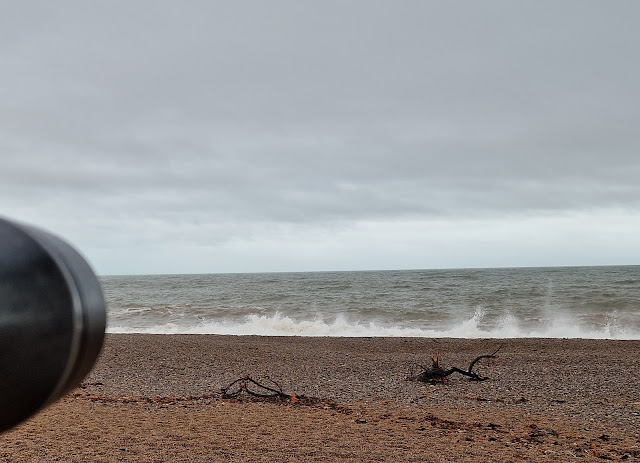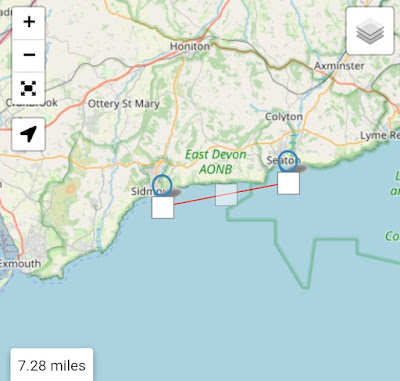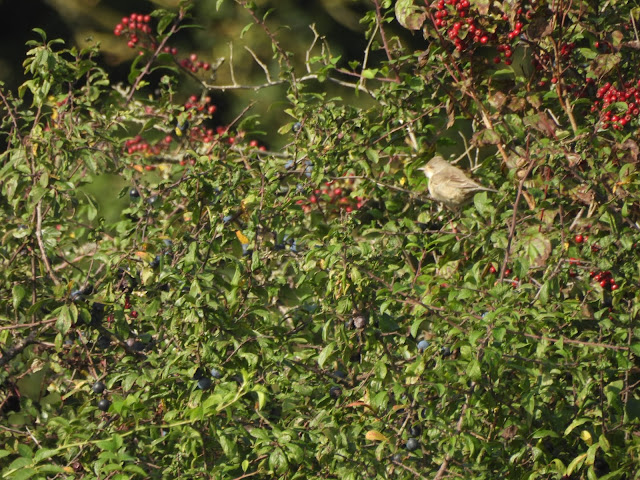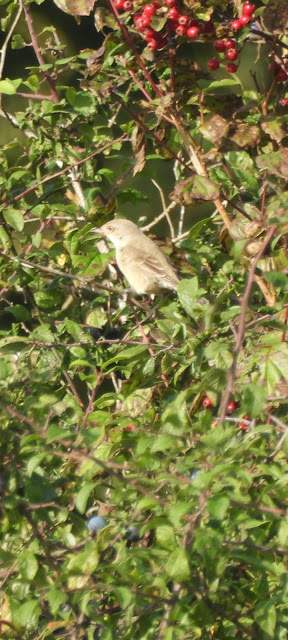Even though I have had a couple of days to recover, my brain still can't compute what I witnessed off Seaton Beach on Friday 13th. And as I cannot even comprehend it myself I have no idea how well I am going to put it into words, but I'll try...
Sea watching on a patch that is so deep in Lyme Bay without any proper headland sets a certain level of expectation, a very low one. And I can honestly say having watched this patch for twenty odd years now, that level of expectation continues to only get lower. We seem to be the poorer relation to everywhere else on the south coast of Devon and Dorset when it comes to sea birds, scarce and common. I would say in general it is only Manx and Balearic Shearwaters and spring Great Northern Divers that we seem to do comparable ok for.
 |
| A spring Great Northern Diver. We must be in the right place in relation to their moulting areas to get a decent passage of these in late April/May each year. |
Does this mean sea watching off Seaton is a waste of time? Not at all. In fact over the years some of my most memorable patch moments have been thanks to birds over the sea, however these moments of magic are brief little nuggets of joy interspersed with many hundreds of hours of being bitterly disappointed. To be honest this is probably one of the main reasons why they are just so special - you have to work for them!
In short, when a Seaton birder goes sea watching, they really are going to watch the sea and only occasionally will a bird interrupt the view. And this is why Friday has completely wrecked me, in a good way. It had everything, and I didn't even have all that much time. I look forward to telling the tale, hope you enjoy the read...
After a mild and rather wind-less week, Thursday evening brought a load of rain with a gusting south veering south-west wind. I actually had some hope for Friday morning, this was because we had food in the bay. Over the previous few days large numbers of gulls had been feeding just offshore with Gannets ever present a little further out, plus the beach has been lined with fishermen which is always a good sign.
My first watch on Friday morning started at 07:40, although I was only able to stay until 08:15 as I had to take Harry to school. So it was only 35 minutes long, but it was the only time I have ever found sea watching off here to be frantic, yes, frantic...
Gannets were streaming through at all distances, as were flocks of Kittiwakes and auks. My counts of these three in the 35 minutes were 370, 128 and c200 respectively. It was like being back at Pendeen - absolutely thrilling but also quite stressful. Two single Balearic Shearwaters came though west at close range, and small groups of Common Scoter went bombing through in both directions.
At 07:50 as I was watching a load of Gannets flying west, another bird came into view amongst them. A few slow and languid shallow flaps later, I realised it was a Cory's Shearwater virtually clipping the tops of the waves as it flew west. It was distant yes but not that distant. I watched it for thirty seconds before zooming up for some plumage details, however this coincided with the arrival of a weather front and viewing became instantly difficult. I knew what it was, but decided to relegate it back to large shearwater sp. without any plumage details.
Ten minutes later however, a little further out but during a period of better visibility, a second large shearwater sp. came into view flying west, but this one flew with stiffer and far less bowed wings. To be truthful from the moment I clapped eyes on it Cory's didn't even cross my mind - this was a Great Shearwater.
This perfect comparison of imperfect views of the two birds in similar conditions gave me the confidence needed to re confirm the ID of the Cory's, and confirm bird two as a Great. Seeing several thousand Cory's and over a hundred Great Shears within the last few months helped too of course! Cory's Shearwater is a full fat patch tick for me, having missed out on all previous records (was not on patch for most of these). Great Shearwater was only my second for the patch following my first a little over three weeks ago.
So that watch in itself was something quite special, but the sea still had a lot more to offer...
I returned to Seaton Beach at 10:30 and stayed for an hour. Conditions were now completely different from earlier with the wind having dropped and the sun mostly out except for the odd passing cloud. Appalling viewing conditions really!
 |
| Took this when there was a decent amount of cloud cover towards the end of the hour watch |
Within this watch was a five minute period that I can only describe as being ridiculous, completely and utterly ridiculous. At 11:16 I picked up a distant Great Skua flying west whilst watching a group of four distant large Shearwaters flying the same way, it was my first Bonxie of the year. As I was watching it a falcon flashed through my scope view really close in low over the sea. It looked small but up until the point I latched my scope on to it I presumed it was just one the local Peregrines - it wasn't it was a stunning juvenile Merlin! A second year tick and a species that can easily be missed in any given year here.
Once I had followed the Merlin as far as I could I started scanning back over the sea and at 11:20 was met with an at first puzzling small gull-like bird that was flying through the worst of the glare. I couldn't figure out what it was for a moment, clearly smaller than a Kittiwake, much narrower winged, but long in the body/tail and not a tern despite flying a bit like one. As it flew a little more west it came out of the glare - it was a skua - a bloody Long-tailed Skua! It kept flying west but then turned and flew more south heading out into the bay. At mid distance it was close enough (when it got into better light) to show it was an intermediate plumaged juvenile, an absolute beaut of one too. Only my third Long-tailed ever here, following a stunning spring adult on the evening of 23rd May 2006 and a juvenile practically over the beach on 20th Oct 2009. Both shared with Gav, who I think has had at least another two here since?
Other birds during this watch included (and I cannot believe I am including the first as a side note) nine very distant large shearwaters, singles of Great Northern and Red-throated Divers (both first of the autumn for me), Arctic Skua, Sandwich Tern and two Brent Geese (dark-bellied) west with twenty Common Scoter east.
After a fairly fruitless look along the Estuary, I returned to the beach for a final bit of sea watching 12:05 - 12:30. I wasn't expecting my first scan to show a single spread out flock of 35 large shearwaters flicking up over the horizon as they went west. And they kept coming...
Over the next 15 minutes I counted 130 large shearwaters west. The light was still awful, in fact worse than the 10:30 sea watch, and although at the time I felt like the nearer ones were giving Cory's vibes, on reflection I can't bet my house on the fact they were so will be keeping them all as large shearwater sp. All I was seeing was them rising up as they glided so couldn't really get a true feel for their flight action, and even the closest ones were a good deal further out than the earlier two.
One shearwater that was identifiable to species level was a single Sooty Shearwater that came sweeping through a group of seven large shearwaters, towering above the horizon several times as it flew west. This was at 12:17 and was my first here for a surprising ten years - the first one that has ever gone through with a flock of even bigger shearwaters though! By 12:21 the shearwater passage had stopped, or more likely drifted further out and over the horizon. A close Arctic Skua, a pale sub-adult bird, flew south east just before I finally had to go.
So there we are... Exactly two hours of sea watching off Seaton on a day that didn't just give me four species of shearwaters (including a patch first and second for me) and three species of skua (including a patch third for me), but a three-figure passage of large shearwaters and a passage of common species on a scale that I have never seen here before. Just incredible.
Another factor that made all this feel a bit surreal was that other than Gav at West Bay, it literally felt like there was no one else sea watching along the south coast up until about mid-late morning. For several hours no news came out out of the main sites like Berry, Start and Portland, and there seemed to be no one watching from the less prime spots like Dawlish, Exmouth, Budleigh, etc. I was really grateful for Gav though (who was chalking up big shears on his patch - read about it here) as on the frequent occasions I found myself in a state of shock at what I was witnessing, I just had to phone someone and verbally express my utter disbelief! Think I called Gav about four times during the morning and am certain that during not one of these conversations did I make any real sense - I just uttered random noises with the odd expletive and species name thrown in. Sorry for that Gav, but I had to share it with someone!
So, does this mean the low bar of Seaton sea watching standards has risen for me? Not a chance. Bloody awful place to sea watch from, usually.






















.jpg)








221023.JPG)














